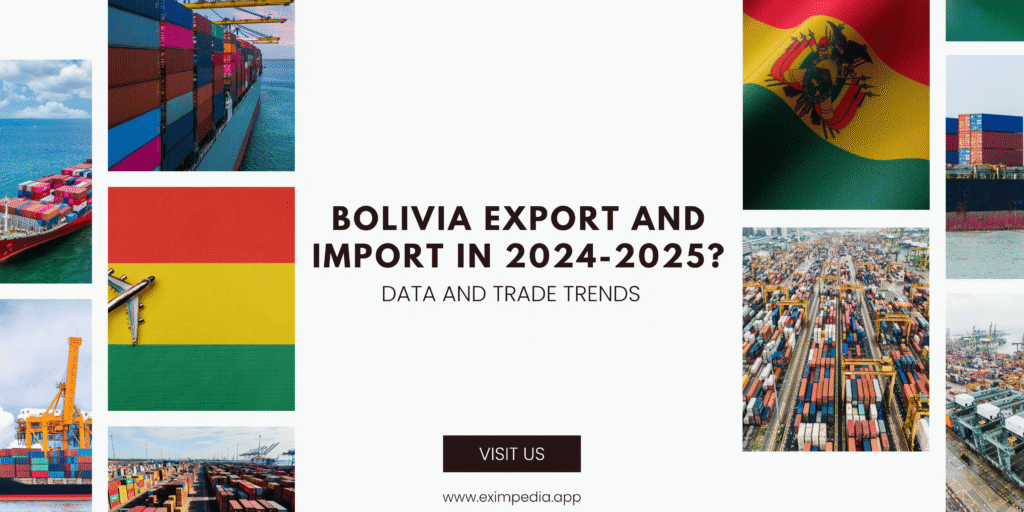
1. Why Is Bolivia’s Export Performance in 2024-2025 Worth Exploring?
Bolivia, a landlocked country in South America, plays a crucial role in regional trade with a growing influence in global markets. As economies recover and recalibrate post-pandemic, understanding Bolivia exports and bolivia export data is essential for businesses and trade analysts seeking market opportunities. The country’s export performance between 2024 and 2025 provides a rich narrative of diversification, mineral wealth, and growing global demand.
2. What Are the Leading Bolivia Exports in 2024?
Bolivia exports are largely driven by its natural resource endowments. According to Bolivia export data, the top exported commodities in 2024 include:
- Natural Gas: Bolivia remains a major energy supplier in South America, particularly to Brazil and Argentina.
- Zinc and Silver: These metals continue to dominate bolivia export data due to consistent global demand.
- Soybeans and Derivatives: An important agricultural export, especially to neighboring countries.
- Gold: A significant contributor to export revenue despite fluctuating global prices.
3. How Does Bolivia Import Data Compare to Export Performance?
Bolivia import data shows a steady demand for machinery, vehicles, refined petroleum, pharmaceuticals, and electronics. These imports support Bolivia’s industrial, health, and consumer sectors. Notably, bolivia imports reflect a growing middle class and increased consumption of foreign products.

4. What Does the 2024 Bolivia Customs Data Reveal About Trade Volumes?
Bolivia customs data from early 2024 indicates a slight trade surplus, mainly due to strong performance in mining exports. Trade with Brazil, China, and the USA saw noticeable increases. The bolivia shipment data also highlights a rise in intra-regional trade, especially within MERCOSUR countries.
5. Which Countries Are Bolivia’s Top Trade Partners in 2024-2025?
Based on the most recent bolivia exports and bolivia imports data:
- Top Export Destinations: Brazil, Argentina, India, Japan, and the United Arab Emirates.
- Top Import Sources: China, Brazil, the United States, Argentina, and Germany.
This confirms the bilateral importance of neighboring economies and growing Asian demand.
6. How Have Market Trends Affected Bolivia Imports and Exports?
From 2024 to 2025, Bolivia’s trade has been influenced by global commodity price fluctuations, geopolitical shifts, and regional integration. A surge in commodity prices improved export revenues. Meanwhile, bolivia imports adjusted due to inflationary pressures and currency fluctuations, impacting consumer goods and industrial inputs.
7. What Does Import Data of Bolivia Suggest About Domestic Demand?
Import data of Bolivia shows robust demand for intermediate and capital goods, indicating industrial development. There’s also a noticeable rise in healthcare-related imports, hinting at public health investment. Additionally, the demand for renewable energy components has grown, reflecting Bolivia’s shift toward sustainable development.
8. Are There Any Notable Changes in Bolivia Shipment Data in 2025?
Bolivia shipment data in Q1 2025 shows a 6.4% increase in total shipment value compared to the same period in 2024. Key categories driving this growth include:
- Renewable energy components
- Agricultural machinery
- Processed food products
This growth in bolivia exports and imports underlines enhanced infrastructure and logistics capabilities.
9. What Role Do HS Codes and Bolivia Customs Data Play in Trade Analytics?
HS codes in bolivia customs data offer granular insights into trade. They help identify top-performing goods, monitor compliance, and assess tariff impacts. Businesses and policymakers use this to navigate international regulations and seize market opportunities.
10. How Can Businesses Leverage Bolivia Export Data for Strategic Planning?
Businesses can use bolivia export data to:
- Identify high-demand markets for Bolivian goods
- Forecast price movements for major commodities
- Track competitor exports and pricing patterns
- Pinpoint new trade routes and logistics partners
11. What Tools Are Available for Accessing Bolivia Import Data and Export Records?
Reliable trade intelligence platforms offer:
- Real-time bolivia customs data and shipment records
- Country-wise bolivia import data and export trends
- HS code-wise classification and port-level shipment information
These platforms support importers, exporters, analysts, and policy planners with actionable insights.
12. How Have Bolivia Imports and Exports Changed Over the Last Decade?
Comparing bolivia imports and exports from 2014 to 2024:
- Exports have become more diversified, with less reliance on hydrocarbons.
- Imports have increased in technology, healthcare, and capital goods.
- Trade balance remains largely stable, with occasional surpluses during commodity booms.
13. What Is the Outlook for Bolivia’s Trade in 2025 and Beyond?
Experts anticipate a 7-10% increase in bolivia exports by the end of 2025, driven by increased global demand for lithium, copper, and agricultural produce. Bolivia imports are also expected to grow as infrastructure and consumer demand expand.
14. How Can Stakeholders Use Bolivia Shipment Data to Gain Competitive Advantage?
Stakeholders can:
- Track shipment frequency and volume trends
- Benchmark trade activity against competitors
- Analyze seasonal and regional export-import flows
15. Why Should You Monitor Bolivia Customs Data Continuously?
Monitoring bolivia customs data helps:
- Spot regulatory changes and tariff updates
- Track disruptions in supply chains
- Ensure compliance and avoid penalties

Conclusion: Why Is Bolivia a Country to Watch for Trade Opportunities?
With expanding mining, agricultural, and renewable energy sectors, Bolivia presents robust trade potential. By analyzing Bolivia export data, bolivia import data, and shipment trends, global stakeholders can make informed, strategic trade decisions.
Access to reliable bolivia exports and imports data is essential for seizing opportunities in South America’s evolving trade landscape. Whether you’re a trader, investor, or policy analyst, Bolivia’s customs and shipment insights are key to navigating its dynamic economic trajectory.